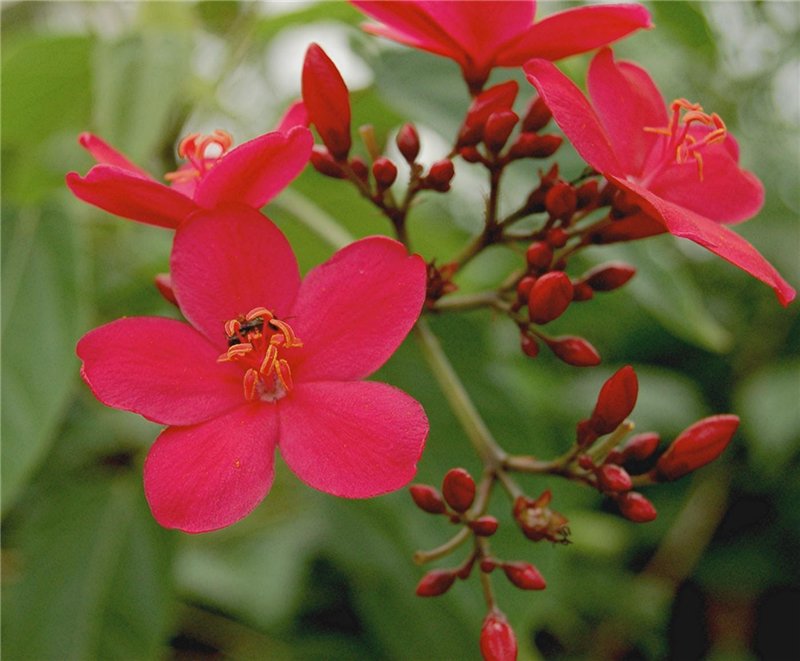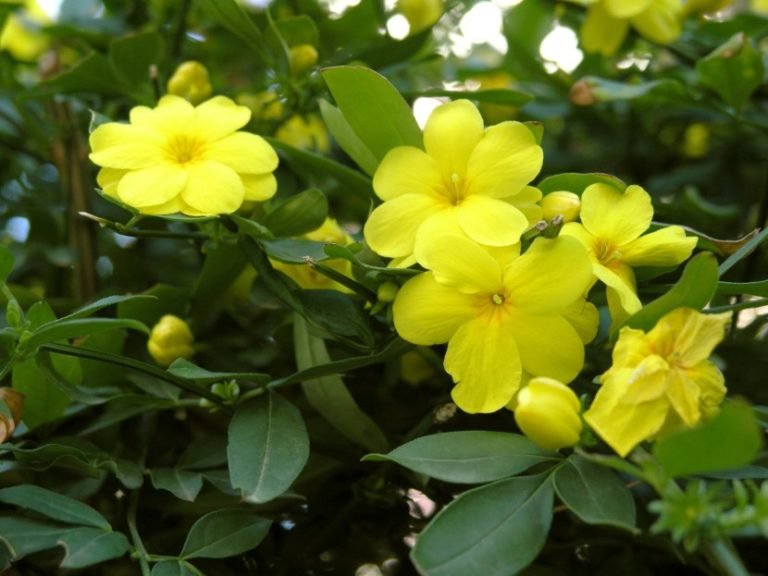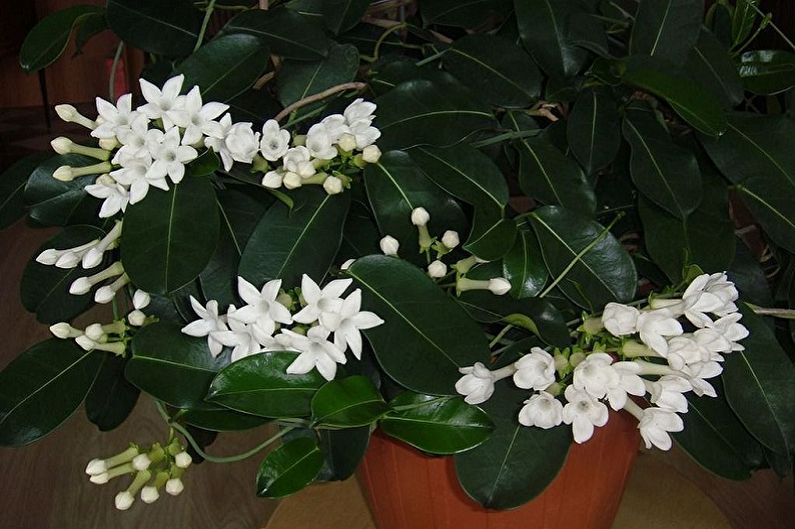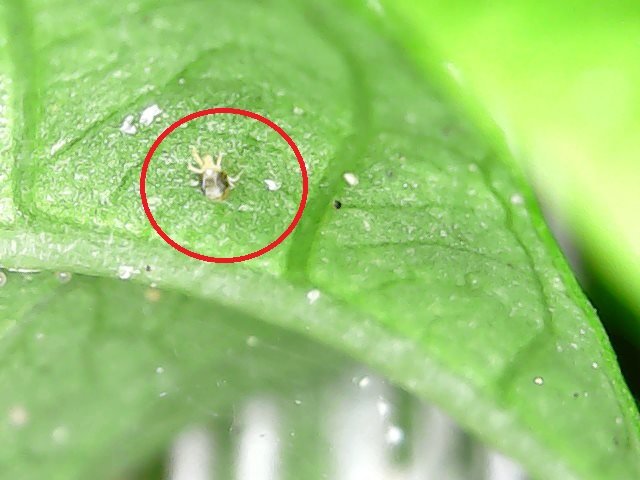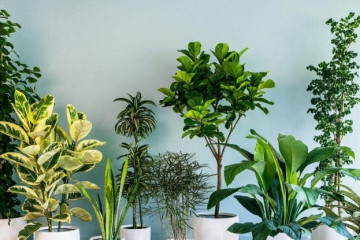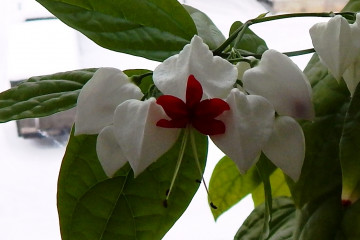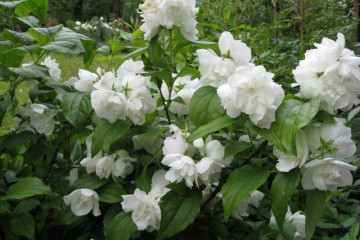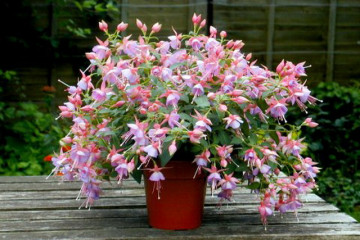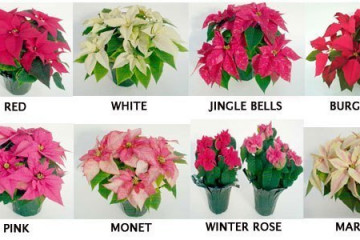Indoor jasmine - how to care
Content:
Indoor jasmine is often used to decorate apartments and houses. This plant is evergreen, it blooms profusely and fills the room with its scent. Caring for jasmine involves following certain rules.
Indoor jasmine - what is this potted flower
Indoor jasmines are of several types, each of which differs in flowering. All plants require almost identical conditions for keeping.
Brief description and history of origin
Homemade jasmine belongs to the Olive family. This genus includes about 300 varieties. For the first time, the flower appeared in Africa, Australia and Asia. Over time, flower growers brought jasmine to Russia and began to breed it at home.
Popular varieties
There are several main varieties of flowers that are grown at home.
Jasminum Beesianum
This is a representative of vines with 2-meter shoots, which are covered with small grooves on top. Active flowering begins in mid-May. Leaves are dark green small, tapering towards the top, opposite. The length of the leaf is 4-5 cm. The difference in this variety is in a brighter appearance. Deep pink flowers with a pronounced fresh aroma.
Jasmine (Jasminum Nudiflorum)
This species is distinguished by rare leaves and graceful shoots. Weak branching is also noted. Another name is winter jasmine. The leaves of the flower are small, bright green. During the dormant period, the leaves completely or partially fall off. It blooms with yellow buds from January to April, the diameter of the flower reaches 3 cm.
Jasmine grandiflorum (Jasminum Grandiflorum)
One of the largest jasmines. The height of the liana reaches 10 m. A distinctive feature is the bare shoots. Leaves are darker elliptical with sharp edges. Flowers are collected at the top with umbrellas. The plant can bloom in June, and this period will continue until October. The shade of the flowers is white.
Jasmine officinalis (Jasminum Officinale)
A plant with thin and smooth branches, which are decorated with leaf blades. The plates are bright green on the front and pale green on the back. Leaves are elongated in shape, there are pointed edges. The flowering period is observed in April. White flowers with long pedicels emerge from the buds.
Jasmine multiflorous (Jasminum Polyanthum)
The multi-flowered species is presented with abundant branching. The height of the liana can reach 2 m. The oval-shaped leaves with embossed edging are arranged alternately. The leaf plate is dark green.
Jasmine low (Jasminum Humile var. Glabrum)
In the wild, this plant is often found in China.It grows at an altitude of more than 1500 m. The species is represented by shrubs and evergreens. A bush with bare shoots and dark green leaf plates. Umbrella inflorescences are present, which consist of fragrant flowers. The flowering period begins in June.
Home care for indoor jasmine
Jasmine is an indoor flower that requires special attention. Having created the required conditions, the plant will delight with its long, beautiful and fragrant flowering.
Illumination and temperature conditions
When growing jasmine, remember that the plant likes diffused bright light. This rule is important to consider if the jasmine in the pot is on the south side. To protect the delicate plant from the sun's rays, you can use a film or transparent cloth.
The location in the northern part will also affect the condition of the flower. Due to the lack of light, growth slows down and flowering disappears. Based on these features, experts recommend placing jasmine on the west or east side.
Jasmine is undemanding to the temperature regime. It is necessary to monitor the temperature only during the flowering period. To achieve lush and large flowers, you need to place the container in a cool room. From March to October, jasmine feels good at a temperature of 19-25 ° C. A flower can bloom in winter if the ambient temperature is no higher than 12 ° C.
Watering rules and humidity
Indoor jasmine and other species should be watered taking into account the stage of flower growth. In spring and summer, the soil of the plant needs intense moisture. Watering is carried out after the topsoil is completely dry.
Particular attention should be paid to watering in winter, as waterlogging can lead to the death of jasmine. Use only boiled, filtered or rainwater. The liquid should be slightly warm, not harsh. You can prevent the negative effect of salts from water on a flower by adding 4-5 drops of lemon juice to the liquid.
To provide a comfortable environment for jasmine, it is necessary to provide high humidity. If the plant begins to dry out or shed its leaves, then place it under a hood for several days and provide ventilation.
Top dressing and soil quality
To understand how to care for jasmine, you need to know the rules of soil selection. The soil for planting a flower must be drained and loose. These flowers prefer substrates of neutral acidity. Often they use universal remedies for indoor plants. Experts recommend adding a little coniferous soil to the substrate. If the grower makes the soil on his own, then leafy earth, peat, humus and sand are taken.
Liquid mineral fertilizer is used 3 times a month, and once every 2 months, you can fertilize the flower with organic ones.
What size pot to choose
The further growth of jasmine will depend on the correct choice of the pot. During transplantation, a container is taken 2-3 cm larger in diameter than the previous one. The height of the pot also increases. In such conditions, the plant is conveniently located and grows evenly.
Pruning and replanting
Pruning is done after flowering. Thus, the growth of flowers is stimulated, the shoots thicken, the bush becomes compact and dense. You can transplant jasmine when the roots are completely entwined with a clod of earth. Adult plants are usually moved to new containers once every 2-3 years.
Features of flowering plants
Indoor jasmine (home care and the main varieties are described above) blooms profusely for a long time. First of all, the correctness of watering, lighting and feeding is reflected on flowering.
A period of activity and rest
With good care, jasmine will delight with its buds for about 4 months. In some cases, it blooms several times a year. How much jasmine blooms depends not only on the conditions of detention, but also on the type of plant.
One inflorescence contains from 6 to 9 small flowers. They give off a slight pleasant smell. Fruits that have faded should be removed to leave the plant energy for further growth and stem formation. The flowers are often bell-shaped and bloom in white.
Bloom toxicity
During the period of active release of buds, jasmine emits an aroma that can spread throughout the room. At this time, the flower pot should be taken out of the room where people are sleeping. Otherwise, the sugary smell will cause headaches.
Reproduction of indoor jasmine
Jasmine can be propagated in two ways: cuttings or layering. The first option is much simpler, therefore it is often used. Reproduction is best combined with pruning. It is during this time that jasmine has a suitable number of healthy cuttings.
For rooting, cuttings are selected that have several nodules and a length of up to 15 cm. Experts recommend placing the seedlings in a transparent glass of water so that it is convenient to observe the growth of the roots. When the roots have reached 1 cm, they are planted in small pots. It is allowed to use root formation stimulants, which significantly accelerate the growth process. The optimum temperature for young seedlings is 21-24 ° C.
Growing problems, diseases and pests
In order to detect the problem in time, it is necessary to monitor the condition and appearance of the plant. The main signs of the disease:
- yellowing, curling or falling of leaves. This problem often occurs due to dry air in the room, overheating, or lack of water. In some cases, such symptoms appear due to the influence of the scale insect or spider mite;
- yellowing of the leaves causes an excess of fertilizer in the soil - chlorosis;
- too dry air affects the tips of the leaves, which dry out;
- long-term absence of flowering requires adjustment of care.
Pests can be prevented by using regularly warm showers and maintaining high humidity. High-quality watering will help avoid problems with the roots, in particular, with their rotting. It should be remembered that the plant is very sensitive to temperature extremes and sunlight.
Adhering to the basic rules, the florist will receive pretty flowers with an unobtrusive aroma that will decorate any room. There are many varieties to choose from that are good and beautiful in their own way.

